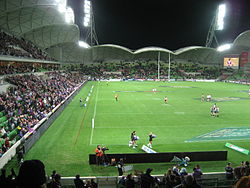| | |
 View of AAMI Park from the tennis centre opposite | |
 | |
| Full name | Melbourne Rectangular Stadium |
|---|---|
| Former names | Swan St Stadium (2007–2010) |
| Address | Olympic Blvd Melbourne VIC 3004 Australia |
| Location | Olympic Boulevard Melbourne, Victoria, Australia |
| Coordinates | 37°49′31″S144°59′2″E / 37.82528°S 144.98389°E |
| Public transit | |
| Parking | Parking available at John Cain Arena |
| Owner | Government of Victoria |
| Operator | Melbourne & Olympic Parks Trust |
| Seating type | All-seater |
| Executive suites | 24 |
| Capacity | 30,050 (total) [1] 29,500 (rugby) [2] |
| Record attendance | Sporting event: 29,902 (31 May 2025; Melbourne City vs Melbourne Victory; A-League Men Grand Final) Concert: 98,136 (over three nights; 10, 11, 12 December 2015; Taylor Swift 1989 World Tour) |
| Field size | 136 m × 85 m (446 ft × 279 ft) [3] |
| Field shape | Rectangular |
| Surface | StaLok Turf |
| Scoreboard | Two curved scoreboards in opposite corners |
| Construction | |
| Broke ground | 2007 |
| Built | 2010 |
| Opened | 7 May 2010 [4] |
| Renovated | 2023 |
| Years active | 2010–present |
| Construction cost | A$268 million |
| Architect | Cox Architecture |
| Structural engineer | Arup Norman Disney & Young |
| General contractor | Grocon |
| Tenants | |
| Rugby League Melbourne Storm (NRL) (2010–present) Rugby Union Melbourne Rebels (Super Rugby and Super W) (2011–2024) Soccer Melbourne City FC (A-League Men and Women) (2010–present) Melbourne Victory (A-League Men and Women) (2010–present) Western United (A-League Men and Women) (2020–2024) Socceroos and Matildas (select international matches) Australian rules football Melbourne Football Club (AFL) (training, 2010–present) | |
| Website | |
| https://aamipark.com.au | |
The Melbourne Rectangular Stadium, currently known as AAMI Park for sponsorship reasons, [5] is a multi-purpose stadium located in the Melbourne Sports and Entertainment Precinct in the suburb of East Melbourne, Melbourne, Victoria, Australia. Built in 2010, it is a rectangular sporting stadium with a capacity of 30,050, and is the home of various rugby league, rugby union and association football teams.
Contents
- History
- Prior to construction
- Notable events hosted: 2010s
- Stadium design
- Features
- Capacity
- Upgrades
- Crowd records
- Concerts
- Sporting events
- Rugby league test matches
- Men's national soccer team results
- Women's national soccer team results
- 2015 AFC Asian Cup
- 2023 FIFA Women's World Cup
- Awards
- See also
- References
- External links
It is Melbourne's first large, purpose-built rectangular stadium. Prior to this project, the primary venues were the oval-configured Melbourne Cricket Ground (MCG) and Docklands Stadium, primarily suited for Australian rules football and cricket. The city's former largest rectangular stadium, Olympic Park, had been repurposed from a track and field facility.
The stadium's occupants include the National Rugby League team, the Melbourne Storm and two A-League Men teams, Melbourne Victory FC and Melbourne City FC, [6] with the stadium having also previously served as the home ground of A-League Men team Western United FC and Super Rugby team the Melbourne Rebels. The venue was one of five chosen for the 2015 AFC Asian Cup, responsible for hosting the inaugural match and six subsequent games, including a quarter-final match. The stadium also hosted matches for the 2023 FIFA Women's World Cup and Four Nations in 2010 and 2014, along with serving as a venue for the 2017 Rugby League World Cup.
While known as the Melbourne Rectangular Stadium during its construction phase, the facility has been recognized as AAMI Park since its inauguration in March 2010, resulting from a sponsorship partnership with the insurance firm AAMI.









